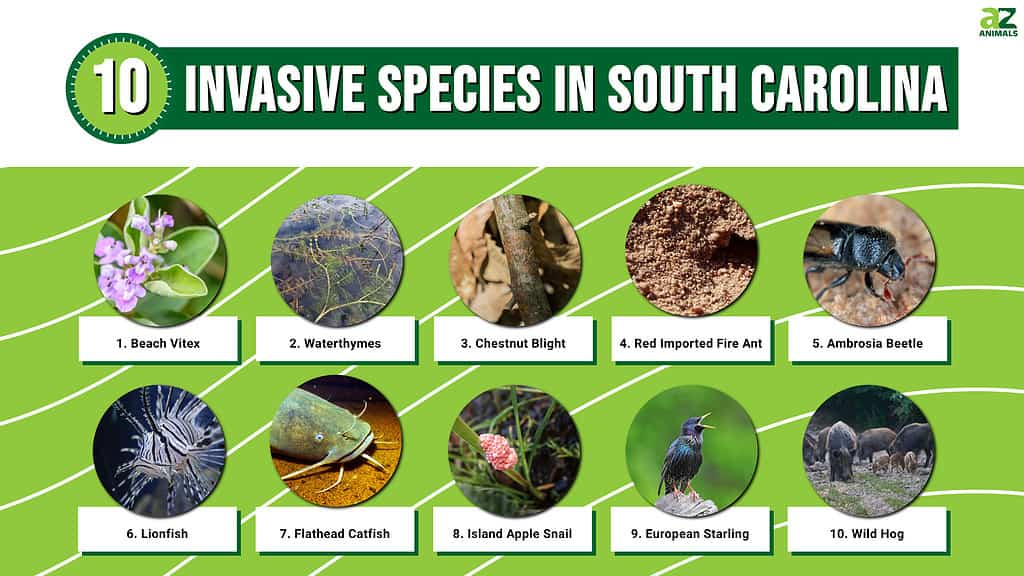
Get ready for an exciting adventure as we dive into the world of invasive species in the beautiful landscapes of South Carolina! We’ll uncover the secrets of these sneaky invaders who have found a way to settle into the vibrant ecosystem of the Palmetto State.
Brace yourself for tales of cunning invaders that disrupt delicate ecosystems, outcompete native species, and leave an indelible mark on the natural balance.
1. Beach Vitex (Vitex rotundifolia)

It was originally introduced from the Pacific Rim in the 1980s for beach stabilization purposes.
©pisitpong2017/Shutterstock.com
Beach vitex, a salt-tolerant perennial shrub, has become an invasive species in coastal regions of South Carolina. It was originally introduced from the Pacific Rim in the 1980s for beach stabilization purposes. Since then, it has spread rapidly across dunes and beaches in both South Carolina and North Carolina.
A vine-like woody structure, beach vitex has almost round leaves, which is why it is referred to as “rotundifolia,” meaning round foliage. The leaves, arranged in pairs along the stem, have a smooth texture similar to fine leather or velvet.
Beach vitex rapidly establishes extensive monocultures through vegetative reproduction and seed production, resulting in the displacement of native dune species, including the rare seabeach amaranth (Amaranthus pumilus) and wild oats.
In addition to the detrimental effects on native plant species, the presence of beach vitex also poses risks to sea turtles, their hatchlings, and birds nesting in coastal dune areas. The dense mats created by these vines can entangle and potentially harm these vulnerable creatures during their nesting processes.
Birds, wildlife, and ocean currents effortlessly disperse the seeds of beach vitex, facilitating its wide distribution.
2. Waterthymes (Hydrilla)
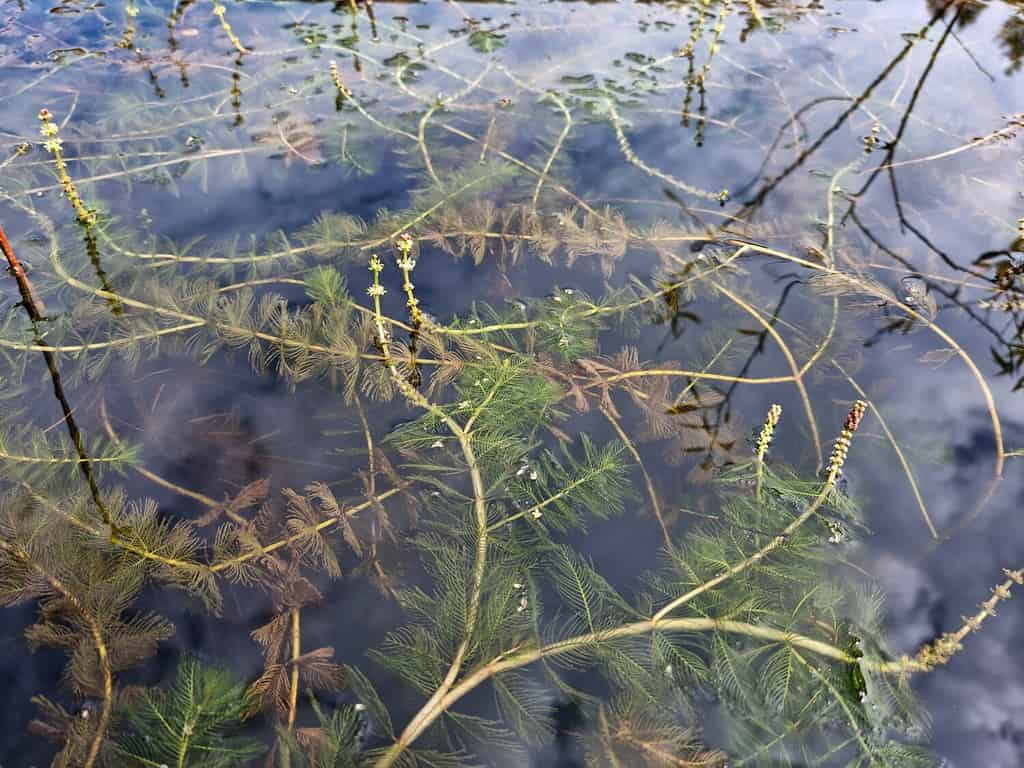
One of the most concerning aspects of Hydrilla is its broad tolerance, allowing it to flourish in nearly any fresh or brackish water body.
©Binimin/Shutterstock.com
Hydrilla, an invasive species, has infested approximately 50,000 acres of South Carolina’s waterways. Originating from Africa and/or Asia, this submersed, rooted aquatic plant was introduced as an aquarium plant in the 1950s. With an impressive ability to thrive in water depths of up to 20 ft, Hydrilla’s growth rate is astonishing, with the potential to increase by up to an inch per day.
The plant’s long stems, reaching 3 to 7 feet in length, support whorls of two to eight leaves. These leaves have serrations or small spines along their margins, while their midribs often exhibit a reddish hue when fresh.
One of the most concerning aspects of Hydrilla is its broad tolerance, allowing it to flourish in nearly any fresh or brackish water body. Unfortunately, the consequences of its infestation are far from benign. Recreation, tourism, and the delicate balance of aquatic ecosystems all suffer as a result.
Hydrilla’s dense vegetation mats pose a serious threat to native plants, which serve as essential sources of food and shelter for indigenous wildlife. As the mats grow towards the water’s surface, they can accumulate to several feet in thickness, effectively shading out and displacing the native vegetation.
It compromises waterfowl feeding areas and fish spawning sites become inhospitable. Furthermore, the presence of Hydrilla disrupts water flow in reservoirs, hampers irrigation canal drainage, and reduces the water’s dissolved oxygen.
3. Chestnut Blight (Cryphonectria parasitica)
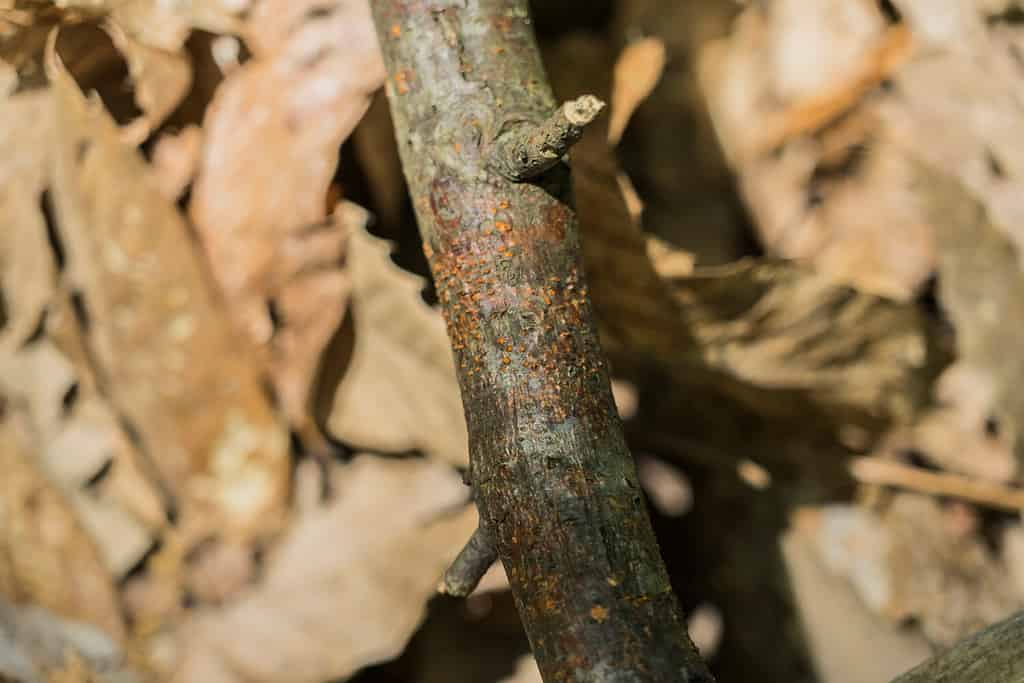
Infected trees display distinctive symptoms, including reddish-brown bark patches that develop into cankers.
©riccardo.calli/Shutterstock.com
Chestnut blight, an invasive species of parasitic fungus, originated in China. It was first discovered in New York City in 1904 and quickly spread, causing extensive damage to chestnut trees from Maine to Alabama by 1926.
The American chestnut, being a newly introduced host tree, lacked any natural defense mechanisms against chestnut blight, allowing the disease to proliferate.
Infected trees display distinctive symptoms, including reddish-brown bark patches that develop into cankers. These cankers have a sunken or swollen appearance, as well as a cracked texture. The disease progresses, leading to the death of twigs and limbs, while the leaves on affected branches wither and turn brown, remaining attached for months. Eventually, the entire tree succumbs to the disease.
The impact of chestnut blight has been devastating, virtually wiping out the Native American chestnut population in the United States and Canada. An astonishing estimate of four billion trees has been lost due to this disease. Creating significant ecological changes within forests and severe economic consequences for industries reliant on chestnut nuts and lumber.
4. Red Imported Fire Ant (Solenopsis invicta)

One significant characteristic of the red imported fire ant is its ability to sting its target repeatedly.
©thomaslabriekl/Shutterstock.com
The red imported fire ant is a small species of ant native to South America. The spread of this species has been significant across the United States, encompassing a region of nearly 300 million acres, which also includes the entirety of South Carolina. These ants are relatively tiny in size, with worker ants ranging from 1/8 to 1/4 inches long, with a dark reddish-brown hue.
One significant characteristic of the red imported fire ant is its ability to sting its target repeatedly. This poses a particular danger to young and newborn animals, as the venom from the stings can be especially harmful to them. In addition to the risks posed to animals, these invasive ants can also have detrimental effects on the environment. They displace native ant species, leading to a reduction in food sources for local wildlife.
The presence of red imported fire ants can also result in various problems for humans. There is a chance of developing allergies upon contact with these ants. Moreover, they can cause damage to fruits, berries, and young crops, impacting agricultural production.
5. Ambrosia Beetle (Platypodinae)
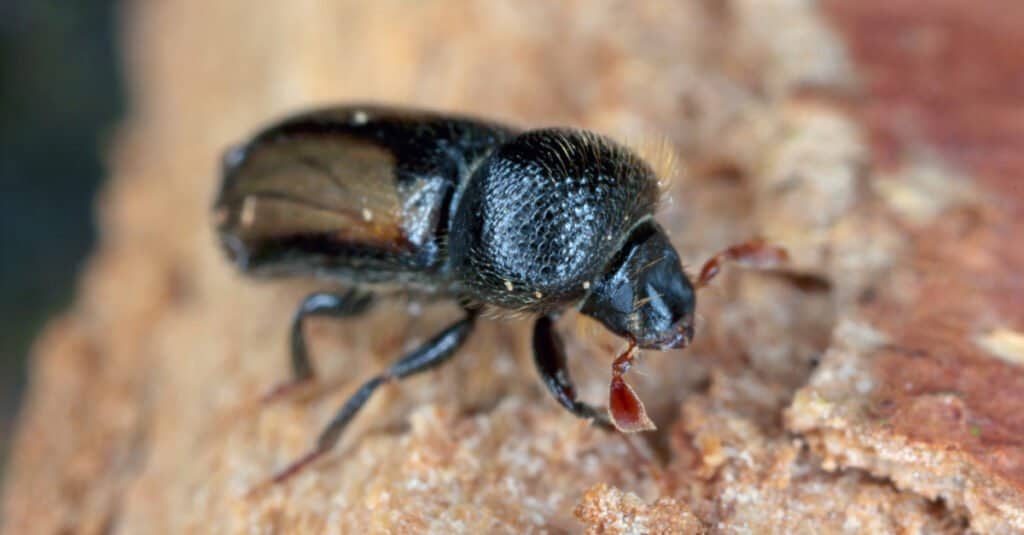
During their lifecycle, they transmit a pathogenic fungus to host trees.
©Tomasz Klejdysz/Shutterstock.com
The ambrosia beetle, an invasive species originally from Asia, was first discovered on peach trees in Charleston in 1974. It has since spread extensively throughout the coastal plain and Piedmont regions of South Carolina
These small beetles generally exhibit a hue that varies from reddish-brown to almost black, with a cylindrical form. Their size ranges from approximately 1/8 to 3/16 inches long.
The life cycle of ambrosia beetles can consist of one or multiple generations per year. During their lifecycle, they transmit a pathogenic fungus to host trees, resulting in a devastating disease known as laurel wilt. This disease has caused the death of up to 98 percent of native host trees that become infected.
The ambrosia beetle targets a variety of trees, including fruit-bearing, nut-producing, and ornamental species like peach, pecan, and persimmon trees. By burrowing into the stems of these trees, the beetles pose a significant threat, potentially damaging numerous trees.
6. Lionfish (Pterois)

Lacking natural predators or substantial competition,
lionfish
exhibit high breeding rates and a voracious appetite.
The lionfish is native to the tropical Indo-Pacific region and began appearing along South Carolina’s coast in the early 2000s. One possible cause of their invasion is multiple escapes into the wild through aquarium releases. Lionfish are favored by aquarists.
These fish possess distinct characteristics such as brown or maroon coloration, adorned with white stripes or bands that cover their bodies and heads. The lionfish’s remarkable striped body and elongated, fan-like pectoral fins make it easily recognizable.
Lacking natural predators or substantial competition, lionfish exhibit high breeding rates and a voracious appetite. The increasing lionfish population exerts additional pressure on coral reefs as they consume herbivores. With the absence of herbivores, algal growth remains unchecked, posing a risk to the overall health of the coral reefs.
Moreover, lionfish prey on native fish species and compete for resources with commercially important species like snappers and groupers. This interference could have devastating effects on both valuable commercial and recreational fisheries.
7. Flathead Catfish (Pylodictis olivaris)
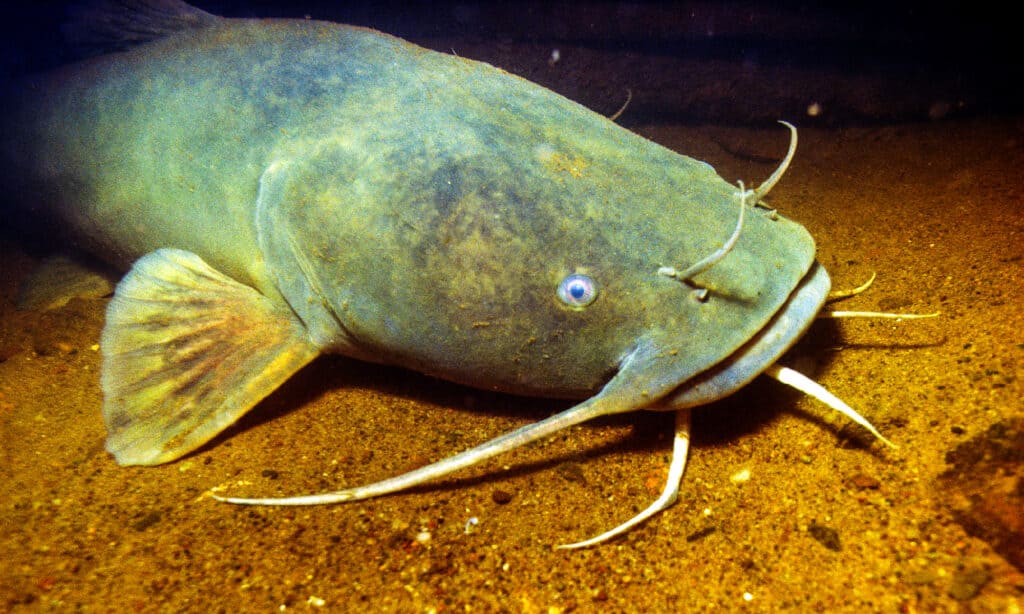
Flathead catfish was introduced to fill up waterways.
©iStock.com/stammphoto
The flathead catfish was intentionally introduced to South Carolina and has since established populations in various reservoirs and river systems across the state, notably in the Santee-Cooper Reservoir.
These flatheads exhibit a distinctive appearance, with pale yellow to light brown coloring on their backs and sides, adorned with black and/or brown mottling. Their bellies typically display a pale yellow or cream hue, while their broad, flattened heads feature a protruding lower jaw.
Regrettably, the introduction of flathead catfish has had significant consequences. They have become a dominant predator, posing a threat to native fish species within their habitats. This invasive behavior is greater because of their role as hosts to over 25 different parasitic species.
The consequences are particularly concerning as some of the native species affected by flathead catfish introductions are federally listed as endangered under the Endangered Species Act.
8. Island Apple Snail (Pomacea insularum)

Similar to other invasive species, the apple snail poses a significant threat to native wildlife by depleting resources.
©Junsang N/Shutterstock.com
The island apple snail, a freshwater snail indigenous to tropical and subtropical regions of South America, has become one of the top 100 worst invasive species worldwide, as documented by the Global Invasive Species Database. It is believed that the introduction of this species to South Carolina can be attributed to its presence in the aquarium trade.
Characterized by its round, spiral-shaped shell, the island apple snail can grow up to 6 inches in length. The shells of these snails typically display various colors, including yellow, black, tan, and brown, with distinct brown bands.
Similar to other invasive species, the apple snail poses a significant threat to native wildlife by depleting resources and disrupting natural ecological processes. Its voracious appetite for plant material leads to the destruction of crucial habitats, particularly affecting native fish and other wildlife species.
By jeopardizing biodiversity and fragile aquatic habitats, these invasive species pose a serious threat to the delicate balance of the region’s ecosystem.
9. European Starling (Sturnus vulgaris)
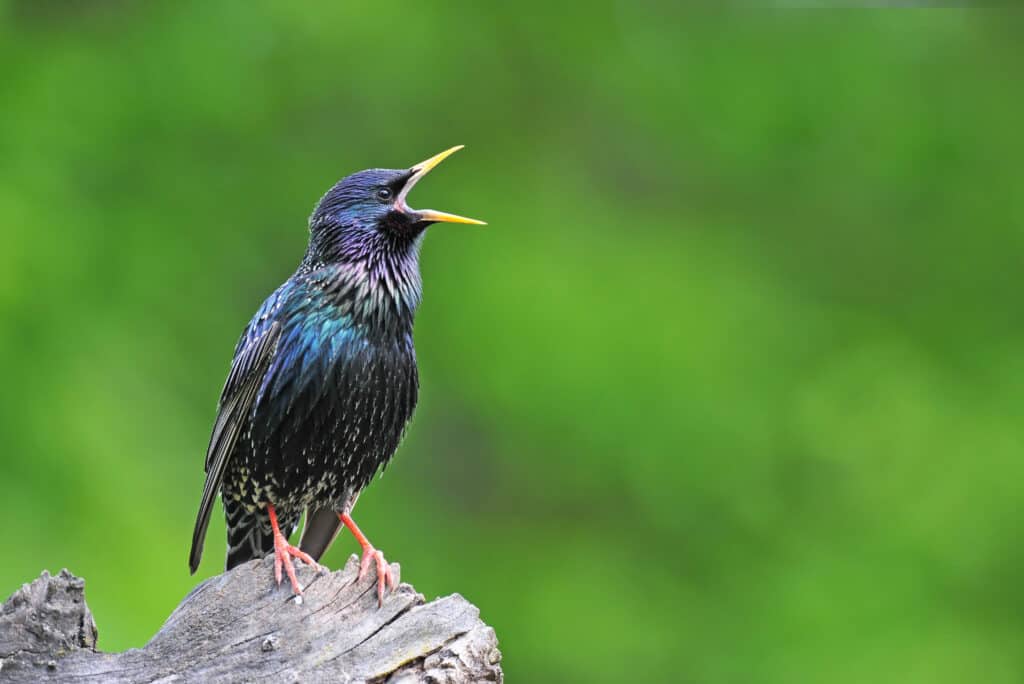
The presence of European starlings in South Carolina poses a threat to various crops.
©Soru Epotok/Shutterstock.com
The European starling, a well-known bird species in South Carolina, is native to northern Africa and Eurasia. It was deliberately introduced to the United States in Central Park, New York, as enthusiasts of Shakespeare’s works desired to see all the avian species in his creations represented in North America.
It took approximately three decades for the European starling to successfully expand from New York and reach South Carolina. The first sighting in Spartanburg was during the spring of 1918.
With their chunky build and similar size to blackbirds, European starlings possess long slender beaks and short tails. When in flight, their wings appear short and pointed, resembling small, four-pointed stars.
The presence of European starlings in South Carolina poses a threat to various crops. They cause damage to blueberries, apples, cherries, grapes, figs, peaches, and strawberries. Apart from directly consuming the fruits and causing losses, starlings also peck and slash at the fruits. They diminish their quality and render them more susceptible to diseases and pests that affect crop production.
10. Wild Hog (Sus scrofa)
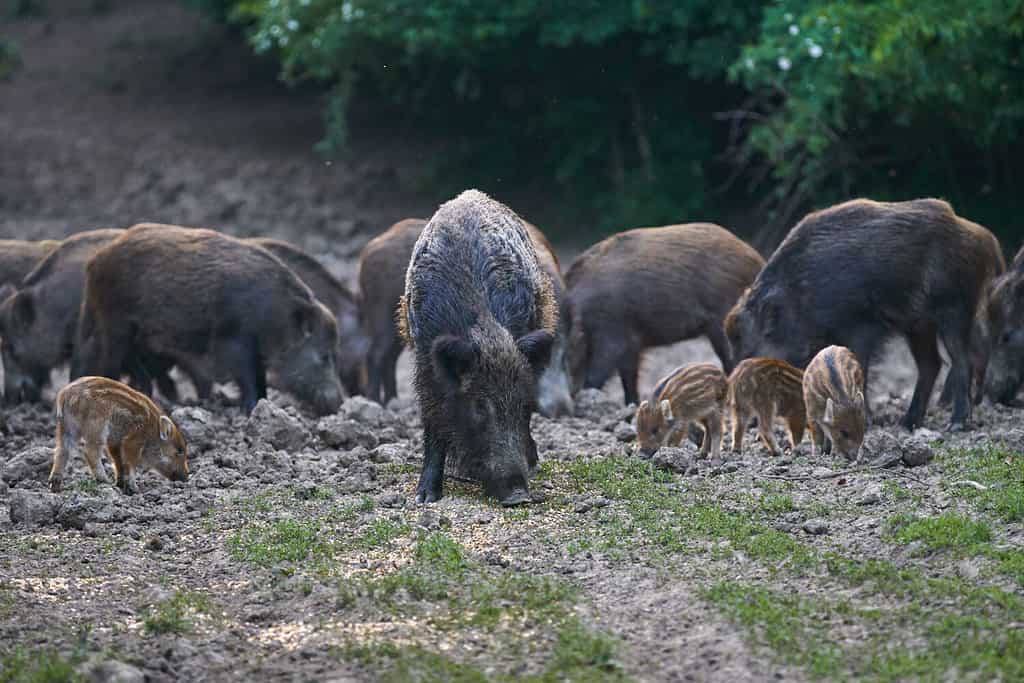
Early explorers and settlers brought hogs over from Europe to use as a food source. Eventually, some of the animals escaped and formed wild colonies.
©Slatan/Shutterstock.com
Since the 15th century, wild pigs have been present along the coastline of South Carolina, brought there by the Spanish. Initially restricted to the floodplains near major rivers, their range expanded into the state’s mountainous regions. Eurasian wild hogs were introduced in the early 19th century.
These wild hogs feature a robust, sturdy build, short limbs, and a distinctive snout. They usually have upright ears and short tails, which can be either curly or straight. Male hogs, or boars, typically weigh between 150 and 200 lbs, with some reaching over 400 lbs. Females are generally slightly smaller.
The financial damages of wild hogs in South Carolina are considerable. There is an estimated $115 million in damages each year to agricultural and non-agricultural areas.
Wild hogs function as ecosystem architects, as they can modify their environment. In wetland habitats, they can impact water quality and runoff. In grassland ecosystems, they can change plant composition and distribution. Furthermore, they are responsible for reducing tree diversity within forests.
Regarded as one of the most harmful invasive species globally, wild pigs go by several names. They are called boar, hogs, feral pigs, swine, or razorbacks. In addition to preying on or competing with native fauna and spreading diseases, their aggressive behavior makes them extremely dangerous.
Summary of the 10 Invasive Species in South Carolina
Here is a summary of the 10 invasive species in South Carolina and when they were introduced:
| Name | Scientific name | When they were introduced |
|---|---|---|
| Beach Vitex | Vitex rotundifolia | 1980s |
| Waterthymes | Hydrilla | 1950s |
| Chestnut Blight | Cryphonectria parasitica | 1904 |
| Red Imported Fire Ant | Solenopsis invicta | late 1930s |
| Ambrosia Beetle | Platypodinae | 1974 |
| Lionfish | Pterois | early 2000s |
| Flathead Catfish | Pylodictis olivaris | 1960s |
| Island Apple Snail | Pomacea insularum | 2008 |
| European Starling | Sturnus vulgaris | 1918 |
| Wild Hog | Sus scrofa | early 1800s |
The photo featured at the top of this post is © Mircea Costina/Shutterstock.com
Thank you for reading! Have some feedback for us? Contact the AZ Animals editorial team.







